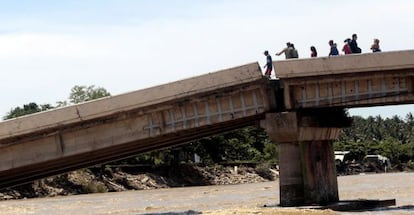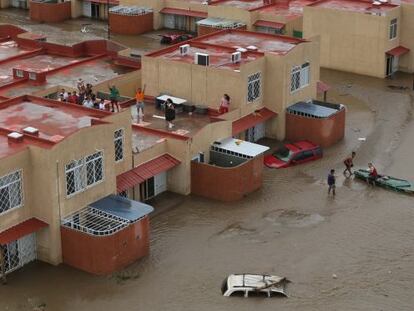Time for some answers
Mexico is asking itself what failure could have caused the floods to turn into a catastrophe of such magnitude


Every year hurricane season hits Mexico between May and October. It's called hurricane season even though many of the storms that form never turn into hurricanes. Tropical storms Ingrid and Manuel didn't need that kind of power although they eventually did evolve into Category 1 storms, before they started tearing the country apart. Now that the heavy rains have stopped, the question that's floating around among politicians and residents is "how could Mexico have been so ill prepared for this kind of tragedy?"
Mexico's House of Representatives held a forum on Wednesday to try to find some answers and a dispute erupted over who should be held accountable. "This is, without a doubt, negligence on the part of federal authorities," said Representative Humberto Armando Prieto, member of the National Action Party (PAN). He said that something had to have failed for the storms to cause at least 97 deaths even though the National Weather Service (SMN) had began sending out alerts since last Wednesday.
One of the alerts dated September 11 warned that "the combination of the two low-pressure systems, one in the Gulf of Mexico and the other in the South Pacific, have the potential to become tropical storms. Heavy rains expected in the next few days." Manuel Huerta, a representative from the Labor Party, denounced the slowness in coordination. The first meeting of the National Civil Defense System took place 4 days after the SMN alert was issued.
Upon analysis experts point out various reasons that explain the disaster. Some of them put the emphasis on weather conditions. "Two tropical storms whip both coasts of the country. That has happened before. Still, it is not very common," said Denis Feltgen, meteorologist at the National Hurricane Center in Miami, Florida. In fact, it had been more than half a century since a natural phenomenon with these characteristics had occurred in Mexico.
Looking beyond the weather conditions that worsened the storms, investigators are asking whether the country was in fact prepared for such an event
The National Hurricane Center tracks and publishes alerts about tropical storms. "We discuss and compare notes with other national meteorological services, Feltgen said. But the final decision about when and where alerts are put out depends on each individual country."
Moreover, something unexpected happened. "The storm on the Pacific coast hovered over Guerrero for hours, flooding one of the poorest regions of the country," explained Dr. Benjamín Martínez López, from the Atmospheric Sciences Center at the Universidad Nacional Autónoma de México (UNAM). Because of this turn of events the alerts sent out from the National Water Commission through the National Meteorological Service proved ineffective.
Looking beyond the weather conditions that worsened the storms, investigators are asking whether the country was in fact prepared for such an event. "Since 2000 Mexico has had an early detection and alert system that offers prognoses and recommends measures to be taken," said Víctor Manuel Velasco, researcher at the Institute of Geophysics at UNAM. "This system has to be modernized and implemented it in a way that helps prevent mudslides and floods," he continued. "We need to get more data from specific points using radars, satellite information, and notes from meteorological centers. We must collect the data, analyze it and make decisions based on that. Many of the fatalities in this disaster were caused by landslides."
Velasco, who said the United States and Cuba are examples to follow, is part of a team of researchers who believe that the formation of hurricane systems is not as random as previously thought. Some regions have a higher risk than others, Velasco said. He insists, as does the entire scientific community, that the only way to prevent catastrophes of this magnitude is early detection, when the margin for action is large enough to implement safety measures. "There is something we can do in response to cases like this: education and preparation are the key to saving lives," said Dennis Feltgen.
Irregular land surveys could also explain the disaster. Ángel Aguirre, governor of Guerrero, mentioned this factor when he told the press that there had been "acts of corruption" that led to the construction of homes "that were not up to code." "It's true that proper land surveys would have helped avoid the landslides," Martínez López said. "Permits were issued for construction on hillsides and low lying areas, in places completely inadequate from a scientific point of view because they flood whenever it rains."
Experts shy away from assigning blame. Instead, they outline all the contributing factors. "The SMN did put out alerts but the provinces were not prepared for what came," Doctor Martínez López said. "In part, they may have thought it wouldn't be as bad, and therefore did not evacuate," he continued. "But it's also plausible that they did not have the sufficient means to do so. For example, only the military could get to most damaged areas. And, on top of that, Guerrero has one of the highest poverty rates. This means terrible infrastructure, shanty towns, and very bad construction plans."
Just as the big 1985 earthquake led to changes in the protocols for planning and building construction in Mexico, Doctor Martínez López believes the storms will teach us some lessons. "Local governments and the military will have to implement their prevention plans," he said. "And now there is more social pressure to revise the laws on land use and for limiting constructions near rivers. There are hotels that are practically on the sea. I think this situation could be a defining moment."
Translation: Dyane Jean François
Tu suscripción se está usando en otro dispositivo
¿Quieres añadir otro usuario a tu suscripción?
Si continúas leyendo en este dispositivo, no se podrá leer en el otro.
FlechaTu suscripción se está usando en otro dispositivo y solo puedes acceder a EL PAÍS desde un dispositivo a la vez.
Si quieres compartir tu cuenta, cambia tu suscripción a la modalidad Premium, así podrás añadir otro usuario. Cada uno accederá con su propia cuenta de email, lo que os permitirá personalizar vuestra experiencia en EL PAÍS.
¿Tienes una suscripción de empresa? Accede aquí para contratar más cuentas.
En el caso de no saber quién está usando tu cuenta, te recomendamos cambiar tu contraseña aquí.
Si decides continuar compartiendo tu cuenta, este mensaje se mostrará en tu dispositivo y en el de la otra persona que está usando tu cuenta de forma indefinida, afectando a tu experiencia de lectura. Puedes consultar aquí los términos y condiciones de la suscripción digital.
More information
Últimas noticias
A floating school teaches children how to save Lake Atitlán
Pablo Escobar’s hippos: A serious environmental problem, 40 years on
The brief rise and retreat of Generation Z in Mexico
From Andorra to Gibraltar, a black market for Ozempic exploits its success: ‘They’re the most sought-after products in the world’
Most viewed
- Why we lost the habit of sleeping in two segments and how that changed our sense of time
- Charles Dubouloz, mountaineering star, retires at 36 with a farewell tour inspired by Walter Bonatti
- Venezuela faces its most tense Christmas yet
- Trump’s obsession with putting his name on everything is unprecedented in the United States
- CBS in crisis after pulling a report on Trump’s deportations to El Salvador (which later leaked online)









































